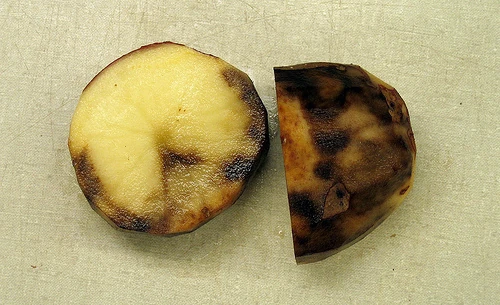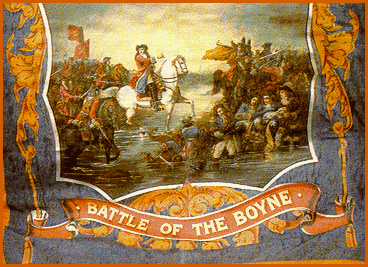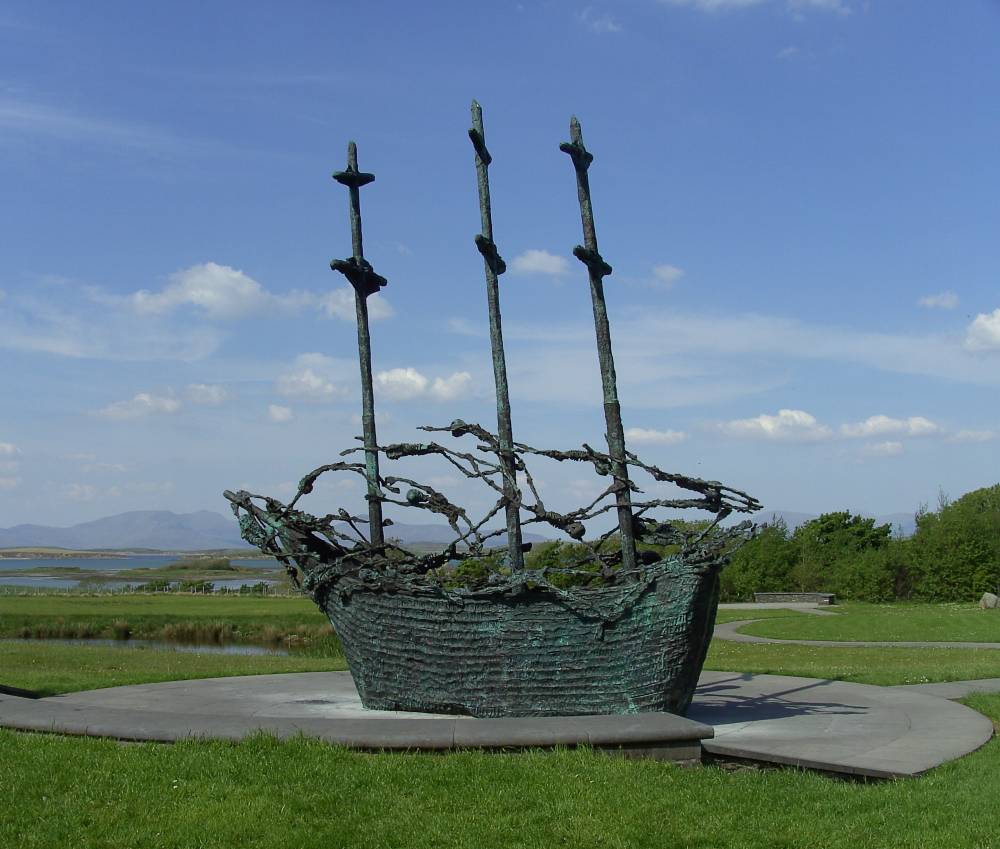Celtic tribes (a group of people from the mainland of Europe) arrived on the island between 600-150 BC. The
name Ireland comes from the Irish word "Eire," which comes from the Celtic goddess named Eiru.
Image credit: http://rs423.pbsrc.com/albums/pp316/cinn613/Goddess/Eiru.jpg~c200
The Celts would often raid the coast of Britain and bring prisoners back to Ireland. On one such raid, they brought back a 16 year old boy named Patrick and put him to work as a shepherd. During this time he took solace in God. After 6 years, he escaped back home where he was ordained. He felt the call to return to Ireland in 432 AD, and set about converting the pagans. He used Irish symbols that the people could understand. For example, he used the 3 leaf clover to illustrate the trinity of God. Also, since the pagans worshipped the sun, he incorporated it into the celtic cross. There is a legend that St Patrick drove all the snakes out of Ireland, and indeed Ireland has no snakes, but the evidence indicates that snakes never existed on Ireland (same as Iceland, Greenland, and New Zealand). We celebrate St Patrick's Day on March 17th each year because that is the date he is supposed to have died, in 460AD.
Imagecredit:http://media.irishcentral.com/images/MI+Whats+behind+the+legend+of+St+Patrick+banishing+snakes+from+Ireland.jpg
Around 800 AD, Viking invaders began raids into Ireland and established settlements, including the capital of Dublin. There were many battles between the Vikings and Celts for 200 years, until a battle in 1014 defeated the Vikings. Peace was short lived, and Ireland was divided into many warring clans.
Imagecredit:http://irishclansnetwork.com/clans/wp-content/uploads/2012/05/genetic-heritage-ireland.jpg
In
1170, Ireland was invaded by Norman Vikings. The Norman Vikings were
originally from Scandinavia, but were called Norman because the
Viking chief Rollo had been granted land by the French king in the
north of France. The Norman Vikings made Ireland an English
territory under King Henry II of England.
Imagecredit:http://downloads.bbc.co.uk/rmhttp/schools/primaryhistory/images/vikings/what_happened_to_the_vikings/vk_bayeaux_sea.jpg
By
the 1600s, England's official religion became Protestant while most
Irish remained Roman Catholic, creating tensions. In 1607, the
Flight of the Earls occurred: leading families of Ulster (northern
Ireland) refused to live under English dominance so they went to
Spain for help but never returned. England kept control of Ireland
by sending Protestant English farmers and landlords to replace the
families that had left.
Imagecredit:https://blogger.googleusercontent.com/img/b/R29vZ2xl/AVvXsEjNk7crDqPiaqe4HLU_9UWdOH45FLRUhn2AkYjloY0cF64CiMmtt5PeLewv2X8gMHTcxgL5-agPGFl4t2HpOR2xAXdg8x-fCoQFM0CVXM_nSotFrdy-vGVAv5wsudxx5_rTfD-ISoFYcpnF/s1600/english_farmer.jpg
In
July 1690, the Battle of the Boyne was fought in Ireland between
Catholic James II and Protestant William of Orange. This was the
last time that 2 crowned kings of England faced each other in battle.
William of Orange won a crushing victory, which ensured Protestant
rule in Ireland for many years.
Imagecredit:http://cbladey.com/boyne/Ban1.gif
In
1692, new laws forbade Catholics to vote, own land, or practice their
religion. The UK had also imposed Corn Laws which imposed steep
import duties on foreign grain. These were a few of the factors that
led to the Great Potato Famine between 1845 and 1852. At the time,
almost half of the population faced poverty and depended heavily on
their potato crops. Diseased potatoes were likely brought by ships
from the eastern United States, and the blight spread quickly.
- Image credit: http://vignette2.wikia.nocookie.net/gardener/images/d/db/Potato_Blight.jpg/revision/latest?cb=20100511182211

Many people were forced to live in Irish poorhouses, and by 1845 there were 123 of them. Families in poorhouses were separated and forced into labour for long hours. Conditions were so bad that the road to a poorhouse was called the "pathway of the dead" because more than a quarter of the people died there.
Imagecredit:http://www.abandonedireland.com/Workhouse_files/Workhouse.jpg
In all, about a million people died, and one to two million more emigrated. Many of the ships that carried Irish immigrants across the Atlantic were called "coffin ships" because of the high mortality rate of the passengers (as high as 50%). Sharks were said to follow the ships because of the high number of bodies thrown overboard. The ships were crowded, the passengers were given little food and water, and disease resulted. This
sculpture by John Behan commemorates the coffin ships, and is
Ireland's largest bronze sculpture. It was unveiled in 1997 to mark
the 150th
anniversary of
the potato famine:
https://www.google.ca/search?q=coffin+ships+ireland&newwindow=1&safe=off&espv=2&biw=1920&bih=955&source=lnms&tbm=isch&sa=X&ved=0ahUKEwiS7qv-3JrLAhUKkoMKHRTSCx0Q_AUIBigB#imgrc=5MglApSb-JCswM%3A
Meanwhile,
a movement for Irish independence had begun, in large part due to the
unfair laws against Catholics. The Easter Rebellion occurred in
1916, when armed Irish patriots rebelled against British troops in
Dublin. The rebel leaders surrendered, and were jailed and executed
by the British.
Imagecredit:http://www.irishtimes.com/polopoly_fs/1.2353912.1442411783!/image/image.jpg_gen/derivatives/box_620_330/image.jpg
From 1919-1921 the Anglo-Irish War was waged between the British and the Irish Republican Army (IRA). After many violent uprisings, the Irish Free State was created within the British Empire in 1922. Britain gave up control of most of Ireland but retained its control over the six counties of Ulster (Northern Ireland). This led to the Irish Civil War from 1921-1923, between those who accepted the treaty and the IRA, who wanted all of Ireland to be independent. The IRA lost.

Imagecredit: https://www.google.ca/urlsa=i&rct=j&q=&esrc=s&source=images&cd=&cad=rja&uact=8&ved=0ahUKEwiL0Zmqi5PLAhUCRT4KHSioAlEQjRwIBw&url=http%3A%2F%2Fcbladey.com%2Firish%2Fmaps.html&psig=AFQjCNGSqlNpR3Gh3RSQI7Hjcl2d6mYJJw&ust=1456495625161101
In 1948, The Republic of Ireland became an independent country, while Northern Ireland remained part of the UK.
image
credit: http://www.mapsofworld.com/ireland/maps/ireland-road-map.jpg
In
1969,
“Troubles” began again between the IRA and the loyalists in
Northern Ireland. In the northern town of Derry on July 30, 1972,
British troops killed 13 unarmed marchers in an event known as Bloody
Sunday. Constant violence continued between the two groups until the
adoption of The Good Friday Agreement, approved by voters in two
referendums held on May 22, 1998.
In
2002,
the
Euro replaced the Irish pound as Ireland's official currency.
Famous people who have come from Ireland include Bono
from U2, Robert Boyle (the founder of modern chemistry), Jonathan
Swift (Gulliver's Travels), C.S. Lewis (the Chronicles of Narnia),
Oscar Wilde (author), William Butler Yeats (poet), and actors Colin
Farrel and Liam Neeson.
Image
credit:
http://thumbs.dreamstime.com/z/old-man-holding-flag-ireland-illustration-white-background-33694168.jpg












No comments:
Post a Comment